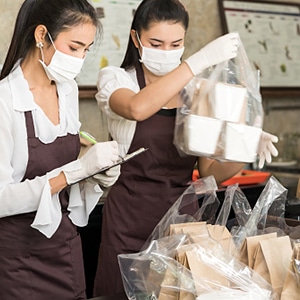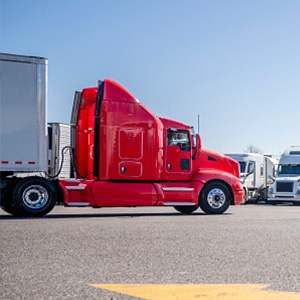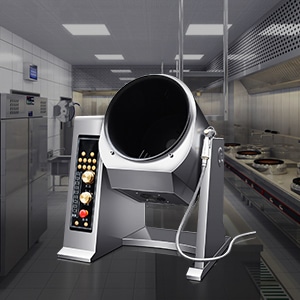How Restaurant Industry are Coping with the COVID-19
We all know that the pandemic has had a huge impact on the restaurant industry worldwide, bringing with it new challenges and trends. Restaurants around the world are actively fighting for changes to adapt to the pandemic period, and Chefmax shares this article to help all restaurant professionals understand the dilemmas and solutions facing the restaurant industry today.
1. Labor shortage
The causes of labor shortage are multifaceted, the most important of which are the prolonged infection brought by the pandemic, isolation, and the reduced or lost labor capacity of some people due to the after-effects.
In Vietnam, for example, according to the report on the impact of COVID-19 on the labor and employment situation in the third quarter of 2021 by the General Statistics Office of Vietnam, the market labor supply has decreased and workers have returned home or been quarantined due to the pandemic, resulting in labor supply shortage in many enterprises. Survey results assessing the nationwide impact of the Covid-19 pandemic showed that 17.8% of 22,764 businesses had worker shortages. Businesses in the Southeast had the highest percentage of labor shortages at 30.6%.
For restaurant decision makers, labor shortages mean that business cannot be conducted properly and labor prices are rising, and the industry has taken a variety of steps to address this issue.
A. Downsizing the business
This is the approach taken by most restaurant owners, partly due to labor shortage, partly due to reduced customer traffic, restaurant business scale down either actively or passively, downsizing can directly reduce operating costs (including reducing the number of preparation, utility expenses and staff wages), many small restaurants to achieve this step by reducing business hours and cutting down the menu.
B. Equipment automation
Highly automated equipment can replace manual labor, such as commercial cooking machines, smart computer-controlled pasta cookers and fryers, and food preparation equipment such as pasta mixers and choppers, which can save a lot of labor and increase efficiency.
Whether following the wave of modern kitchens or dealing with labor shortages and rising prices, more and more operators are looking for more automated equipment, and in their view, even though the expense of purchasing automated equipment is higher than traditional equipment, the extra money can be made up.
C. Retention of employees
These retained employees are so important that without them, the business cannot function properly, and in the case of labor shortages, there is no guarantee that their vacancies will be filled in a timely manner. In such times, employees take on more work, including sharing the work of other departing employees and responding to pandemic disinfection efforts, and they need to be given higher levels of attention and treatment, so listen to your employees’ ideas and make improvements within reason.
2. The Infectious Disease Epidemic
Even though the restaurant industry has recovered somewhat, the Covid-19 pandemic is not yet over, and it has permanently changed some of the way the restaurant industry thinks about doing business. Reducing exposure and curbing transmission is the new direction every business is considering, which has accelerated the development of contactless payment and pickup.
A. No-touch pickup and takeout
Fast food chains such as McDonald’s and Burger King have made improvements around the drive-thru window to maintain a social distance below the epidemic-proof standard for curbside contactless pickup, using online payment methods that eliminate the need for customers to get out of their cars and hand over bills.
A simpler way is takeout, which is increasingly chosen by both merchants and customers. This contactless pickup meets the needs of customers who can’t go out or don’t want to dine-in, provides more jobs for the unemployed, and is a way for merchants to expand their revenue streams, even though delivery can be more expensive than in-store, but that hasn’t stopped the growth of the takeout business.

B. Ghost Kitchen
Ghost kitchens are kitchens that completely shut down the dine-in area and only perform take-out service or prepare finished and semi-finished products for other restaurants. Unlike traditional restaurants, there will be no customers here, so they are called ghost kitchens in the dark. In recent years such kitchens have become more and more common. During the pandemic period, operating only the kitchen greatly saved the cost of running a restaurant, and many owners of ghost kitchens abandoned their previous restaurants to reduce the rent and rented only a small area for the kitchen to operate.
C.QR code menu and e-wallet
The rise of contactless payment is another trend in the restaurant industry, reflected in QR code menus, delivery mini-programs, and payments on restaurant websites. Instead of going to the counter or communicating with waiters to order, customers can simply scan the QR code menu on the table and order. Customers who do not visit the restaurant can easily complete the selection and order through online payment. These developments not only bring convenience, but payment without change exchange also reduces the risk of virus transmission to a certain extent.
D. Pandemic prevention measures
Under the influence of the pandemic, consumers will prefer to dine at restaurants with epidemic prevention measures in place, and many restaurants have written their efforts in epidemic prevention on their official websites to create an atmosphere of safety and peace of mind.
The first step is to change the layout of the restaurant, with crowded table arrangements being abandoned and sufficient social distances being left empty to meet pandemic preparedness requirements, including the use of Plexiglas for partitions. Outdoor dining is better ventilated, and many restaurant owners are shifting as much of the dining area as possible to the street and patio.
The next step is to sanitize at the end of each customer’s meal, and even if the extra sanitizing isn’t necessary, remember that you need to make this visible to your customers. In your restaurant, staff should wear a full complement of protective products, including masks and gloves.

3. Supply chain shortage
The supply chain shortage brought about by the pandemic includes two aspects: the increase in the price of ingredients, and the lack of supply of machinery and equipment, slow transportation time and higher prices. This result is exacerbated by the combined effects of labor shortages and inflation. The restaurant industry’s response to the supply chain shortage is reactive; you can’t influence the entire chain, but you can actively respond to it.
A. Modify the menu
This is an easy way to deal with rising produce prices, and although you may be hesitant, it is best to move those ingredients with severe price premiums out of consideration, for which menu modifications are required. To keep the menu rich, you can also additionally find and use ingredients with less pronounced price increases to create dishes and add them to the menu.
In addition, cutting back on other non-essential items can also reduce your operating costs by eliminating the need to spend extra money on purchasing and storing these non-selling items. If necessary, long-term contracts with suppliers can also reduce supply prices, but only if you have a large and long-term demand.
B. Breakdown insurance
You will find that when acquiring kitchen equipment and parts, many deliveries run slow, especially by sea. Under the influence of epidemic prevention measures, parts and equipment are difficult to receive. Businesses that need new equipment for their business may be able to wait a few more days, but practitioners who urgently need parts to repair their existing equipment are in a difficult situation, and the blow to business when commercial kitchen equipment is not working is huge.
In addition, you can try to insure the equipment to reduce the loss due to failure to repair in a timely manner, and determine all the details of after-sales service with the supplier of the equipment and obtain their commitment.

C. Proper maintenance of equipment
Proper cleaning and maintenance of equipment can reduce the probability of failure and extend the life of the equipment, commercial kitchen equipment manufactured in accordance with industry standards, its failure rate will be lower than that of household equipment, and improper cleaning and maintenance is often a major cause of equipment failure. Think of dusty refrigerator filters and clogged burner holes. If not cleaned and unclogged in a timely manner, they can damage components and cause irreversible results.
4. Consumers are patronizing less
This is a very real problem, on the one hand, people still live under the shadow of the pandemic and try to go out as little as possible, on the other hand, inflation and unemployment increase means that most people’s income decreases and they probably can’t afford to go out for dinner every week, so the turnover of casual restaurants generally decreases, in contrast, some fast food chains’ sales increase, which indicates that under the influence of the pandemic influence, people prefer cheaper and more practical restaurants.
A. Increase the mobile experience
People are spending less time out of the house, which naturally leads to more time on the Internet, even if it’s not due to the pandemic, and in recent years people have become more eager to gather information from social media, as evidenced by the proliferation of hot spots and popular restaurants on all types of social media.
In addition to actively sharing useful information and interacting with potential consumers on social media, creating your own website and sending emails can also enhance the mobile web experience, and people will build trust in your restaurant from these positive interactions.
B. Try new interactions
Are you focusing on your community as you increase your investment in marketing? The epidemic has gone some way to strengthening people’s connection to their communities, in large part by helping each other within them.
Whether you’re marketing a soccer game or Thanksgiving, most of the customers who come to your restaurant are also part of your community (pandemics affect out-of-home and out-of-town travel to a certain extent), and by adding some element of communication from your community after promoting safe dining and promotional food, people will be happy to come to your restaurant.

5. Declining revenue
Declining revenue is an inevitable dilemma, and with the downward pressure of the world economy and the pandemic, many potential customers are now choosing to cook their own meals as an economical and safe option, and the answer to how the restaurant industry can mitigate the decline in revenue that comes from experiencing multiple dilemmas is to expand revenue sources.
Many restaurants have increased the diversity of items sold, with semi-finished and online courses in addition to take-out. Some restaurants with a clear perception of their brand have not given up on building their virtual brand image, and they include or sell postcards, fans, tote bags or T-shirts with the restaurant’s logo and philosophy printed on them with their meals, providing a personalized experience that customers will remember.
Summary
The coronavirus pandemic has changed the world, and the restaurant industry as a tertiary sector has been deeply affected, and we need to do better to keep our business going. Chefmax believes that, in any case, the most important thing is to respond positively to these dilemmas, adapt to new trends, and provide a safe dining environment for our customers, where sincerity wins the day.

























